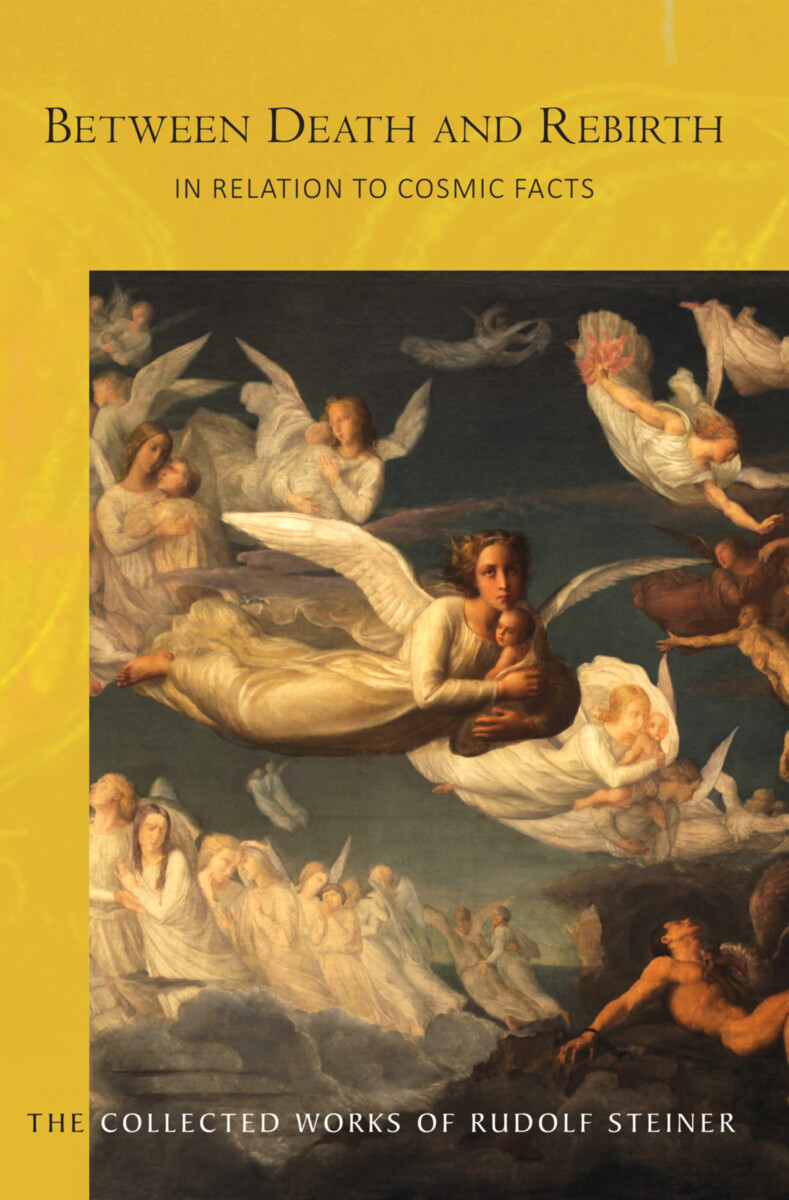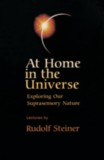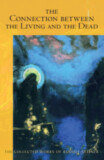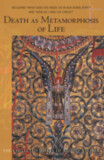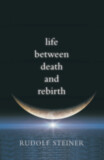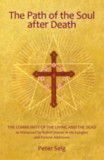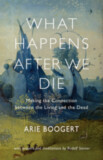Between Death and Rebirth
In Relation to Cosmic Facts (CW 141)
Translated by E. H. Goddard, Dorothy S. Osmond and Frederick Amrine
Introduction by Frederick Amrine
- Publisher
Rudolf Steiner Press - Published
11th March 2022 - ISBN 9781855845930
- Language English
- Pages 254 pp.
- Size 6" x 9.25"
10 lectures, Berlin, November 5, 1912 – April 4, 1913 (CW 141)
“For some years now, the relationship of human beings living on the physical plane to the spiritual worlds has changed.... Now we are living in an age when the soul needs only to be receptive and duly prepared, and then revelations from the spiritual worlds will be able to flow into it. Individual souls will become more and more receptive and, being aware of their task in the present age, they will find this inflow of spiritual knowledge to be a reality.” — Rudolf Steiner (Nov. 5, 1912)
In this absorbing series of lectures, Rudolf Steiner discloses factors in our life on Earth that will influence our experiences in the spiritual world after death—and, conversely, factors in the spiritual world that will affect our next life on Earth. He focuses on the period in the afterlife when an individual has been through kamaloka, the “purgatory” in which one’s soul is purified. Once the soul has been cleansed of its astral sheath, it becomes open to cosmic influences and expands into the planetary sphere, where it can begin preparation for reincarnation and a new human life on Earth.
Steiner addresses the vital relationship of the living to the dead—in particular, how those on Earth can influence the souls of those who have died. He also discusses sleep and death and our seven-year life cycles. In addition, he offers a “Christmas gift” in the form of a lecture on Christian Rosenkreutz and Gautama Buddha, ending with a grand picture of the Mystery of Golgotha—showing that Jesus Christ’s death on the cross only seemed to be a death, whereas in reality it enabled the momentous birth of the “Earth Soul.”
Long out of print, the freshly revised text in this new edition is complemented with an introduction, notes and appendices by Prof. Frederick Amrine and features an index.
This volume is a translation from German of Das Leben zwischen dem Tode und der neuen Geburt im Verhältnis zu den kosmischen Tatsachen (GA 141).
CONTENTS SYNOPSES:
Lecture 1, Nov. 5, 1912: All the forces of the soul must be activated to grasp the essence of Anthroposophy. Subjects must be studied from ever-new sides. Since the last third of the nineteenth century, the soul only needs to be duly prepared, and revelations will flow from the spiritual world. Activity in the physical world, quietude in the spiritual world. Since 1899, spiritual influences must take effect inwardly instead of being occasioned by outer events. These lectures will deal with the life after death after the Kamaloka period. After death, relationships among individuals continue as they were during life on Earth. Homer's clairvoyance. Michelangelo and the Medici tombs in Florence. Our attitude toward spiritual knowledge can establish the seeds of a genuine morality. Companionship or isolation in the planetary spheres after death depend upon moral and religious attitudes of soul in earthly life. For karmic adjustments, return into the physical body is essential.
Lecture 2, Nov. 20. 1912: Consciousness of the “I” acquired through contacts and collisions with the outer world and the body when waking from sleep. Between birth and death, human beings may reduce the value of their “I” by causing suffering to others. Effects of the destruction thus caused remain in his astral, etheric, and physical bodies; the forces able to repair the damage to these sheaths cannot be drawn from the Earth, but only from the planetary spheres after death. Certain qualities acquired on Earth determine the experience of companionship or isolation by the soul after death when passing through the spheres of Mercury, Venus, Sun, Mars, Jupiter, and Saturn. Experiences during Initiation are closely akin to those during the life after death. Understanding of every human soul without distinction of creed necessary for Initiation as it is in the Sun sphere. The meeting between Abraham and Melchizedek contains a deep secret concerning humanity’s evolution. The distinction between Christianity and other faiths. The Mystery of Golgotha was fulfilled for everyone, not just for self-described Christians. “Ye shall be as Gods”—implications of these words differ when spoken by Lucifer or Christ. Forces needed for renewal of the etheric body in the next incarnation must be drawn from the Sun sphere to renew the astral body from the other planetary spheres.
Lecture 3, Dec. 3, 1912: Relationships established during earthly existence cannot initially be changed during life after death; power is gained to change conditions in later karma through any suffering caused by this realization. Those living on Earth are able to have a great influence on those who have died. Reading to the dead. Opposition to Anthroposophy in the upper consciousness may take the form of longing for it in the subconsciousness. Need for mediation between the physical world and the spiritual world. Possibilities that do not become reality on the physical plane exist as forces and effects in the spiritual world; actual experiences are a small part of the possibilities. The purpose of Anthroposophy is fulfilled in the creation of an actual link between the physical and spiritual worlds. The relationship between soul and body. Analogy of the plant and its connection with the Sun. Humanity belongs to the universe, not just the Earth; only in the past four centuries has consciousness of this connection been lost. The Christ Impulse imparts feeling of kinship with the macrocosm. A twelfth-century allegory.
Lecture 4, Dec. 10, 1912: After death, human beings draw forces from the stellar world to the extent to which one developed moral and religious qualities during life on Earth. Humans are not meant to witness what happens to them while asleep—i.e., the restoration of forces spent while awake. Processes of cognition are within the field of our consciousness, but the life-giving process does not. The expulsion from Paradise. The purpose of life between death and rebirth is that forces may be drawn from the stellar world for shaping the following incarnation. Difference between life after death and the condition of sleep is basically one of consciousness. Direct astronomical vision in ancient Egypt, but without logical thinking. In the Greco-Roman epoch there were only memories of what had formerly been direct vision. By the time of Copernicus, human beings had eyes only for physical globes in space. Kepler's spiritual insight into the connection of certain events with heavenly constellations. Anthroposophy is a torch that illumines the spiritual world for us from a certain time onward during life after death. Forces once drawn from the stellar worlds must now be drawn from our own souls. This is the mission of the Earth.
Lecture 5, Dec. 22, 1912: This was a special lecture given “as a kind of Christmas gift” on the subject of Christian Rosenkreutz and Gautama Buddha—their missions and achievements in the spiritual history of humankind.
Lecture 6, Jan. 7, 1913: In our fifth post-Atlantean epoch, the sixth epoch is prepared in human souls by increasing our understanding of the Christ impulse and the mystery of the Holy Grail. The latter is connected with the mission of Buddha in the Mars sphere (mentioned in the previous lecture). Of the members of human being, it is basically the “I” that passes through all the periods of existence between birth and death and between death and rebirth. But this ”I” must not be confused with the “I” recognized in earthly life. The true “I” is the actor in the processes of learning to walk, to speak and to think. There is a natural correspondence between the true form of man and those faculties. The human form stems from the Spirits of Form. These spirits are opposed by unprogressive luciferic spirits that suppress the consciousness proper to the “I.” The bodily organs are pervaded differently by the Spirits of Form in each case. Contrast between the head and the rest of the physical body. At a certain stage of development, physical mobility can be held still while complete mobility of the corresponding etheric organs is maintained. Between death and rebirth human beings experience the higher “I” of which we are unconscious between birth and death.
Lecture 7, Jan. 14, 1913: Cyclic seven-year periods in life. Coming of the second teeth marks the culmination of the formative process that works from within human beings. But growth continues until stopped by forces working from outside. The work of the “regular” hierarchies and of the luciferic beings belonging to those hierarchies. Essential changes take place in time during life on Earth and after death. “Public opinion” and its influence. St. Paul's profound esoteric knowledge exemplified in his teaching of the “first Adam” and the “second Adam.” Progressive dimness of the human life of soul after death until the Mystery of Golgotha, when the new impulse was given to spiritual life. The Baptism by John the Baptist and its effects. In the soul life, human beings were under the leadership of the third hierarchy to a greater extent than after the Mystery of Golgotha. The power and influence of luciferic beings are insignificant for human life after death. The effect of the Buddha's influence in the Mars sphere (see lect. 5). In the future, it will be characteristic of those who are to become spiritual leaders on Earth that a fundamental change takes place in their whole character when they have reached a certain age; this is the result of the Buddha's influence in the Mars sphere during their life between death and rebirth. Rosicrucianism has always recognized this.
Lecture 8, Feb. 11, 1913: The greatest mysteries of existence are within us. The thoughts conceived by divine-spiritual beings in the past live on in the present mineral, plant, and animal kingdoms, just as our memory pictures continue into our present life. With our memory, we grasp a tiny corner of cosmic creation—namely, what has passed from creation into existence. From the viewpoint of sleep, we see what is hidden from waking life. Results of destructive processes during waking life are repaired during sleep. Processes of destruction in the organism are the precondition of soul life. Experiences during life between death and the new birth. At a certain point, vision is reversed; everything outside us in life on Earth becomes our inner world. Preparing the body of the future earthly existence. When the soul encounters in the spiritual world what bears a new life seminally within it—this is a reverse experience of the moment of the last death. Vision of spiritual realities are gradually lost by human souls in the course of evolution. Humankind is now becoming interested only in what is subsensory—e.g., vibrations, wave lengths, the activities of forces. The mission of Anthroposophy is to counter the withering of human inner spirituality.
Lecture 9, Mar. 4, 1913: Spiritual investigation discloses that the suprasensory forces needed by human beings to mold their body and destiny are received from beings of the hierarchies they contact between death and rebirth. Rejection of spiritual ideas in earthly life means loneliness and darkness in the spiritual world after death, as well as an inability to mold the physical organs efficiently for the next incarnation. Individuals after death are approached by luciferic or ahrimanic beings according to their attitude toward spiritual knowledge while on Earth. The power exercised by ahrimanic beings during a soul's life after death can be seen in characteristics of three successive incarnations. An example—egoistic mysticism in one life, hypochondria in the next, and defective thinking in the third. Acting out of love rather than merely out of a sense of duty enables contact after death with spiritual beings who send health-promoting forces into the physical world. Life in the spiritual world depends on the mode of our life in the physical body on Earth. Relationship with the Buddha can be established during the life between death and rebirth, even when there was no contact in earthly life, but this is rare. Nothing can replace the significance of our connection with the Earth. Words of Leonardo da Vinci. Anthroposophy can bridge the gulf between the living and the dead.
Lecture 10, Apr. 1, 1913: Reference to the book Theosophy, chapter 3, on the soul world, the soul in the soul world after death, the spirit land, the spirit in the spirit land after death. These descriptions are more closely related to inner conditions of the soul, whereas in the present lecture-course the descriptions are of great cosmic conditions and the functions of the planetary spheres. Experiences of the soul after death in Kamaloka and final discarding of longings connected with earthly life. Passage through the planetary spheres. Quotation from the book Theosophy with special reference to experiences in the Mars region and the mission of Buddha (lecture 5). At the beginning of the seventeenth century Brahmanism was absorbed into Buddhism in the cultural life of India. Events on Earth are reflected images of happenings in the Heavens. The fruits of the soul's experiences beyond the Saturn sphere between death and rebirth make progress of culture on Earth possible. The stream of spirituality which has its center of gravity in the Mystery of Golgotha comes from ancient Sun. The death on Golgotha was only seemingly a death; in reality it was the birth of the erthly soul.
Rudolf Steiner
Rudolf Steiner (b. Rudolf Joseph Lorenz Steiner, 1861–1925) was born in the small village of Kraljevec, Austro-Hungarian Empire (now in Croatia), where he grew up. As a young man, he lived in Weimar and Berlin, where he became a well-published scientific, literary, and philosophical scholar, known especially for his work with Goethe’s scientific writings. Steiner termed his spiritual philosophy anthroposophy, meaning “wisdom of the human being.” As an exceptionally developed seer, he based his work on direct knowledge and perception of spiritual dimensions. He initiated a modern, universal “spiritual science” that is accessible to anyone willing to exercise clear and unbiased thinking. From his spiritual investigations, Steiner provided suggestions for the renewal of numerous activities, including education (general and for special needs), agriculture, medicine, economics, architecture, science, philosophy, Christianity, and the arts. There are currently thousands of schools, clinics, farms, and initiatives in other fields that involve practical work based on the principles Steiner developed. His many published works feature his research into the spiritual nature of human beings, the evolution of the world and humanity, and methods for personal development. He wrote some thirty books and delivered more than six thousand lectures throughout much of Europe. In 1924, Steiner founded the General Anthroposophical Society, which today has branches around the world.


